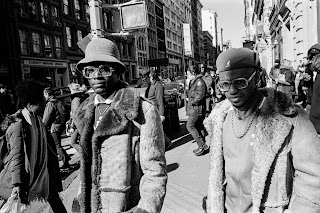people watching and street photography.
Street photography is a genre of photography that records everyday life in a public place for artistic purposes. The publicness of the setting enables the photographer to take candid pictures of strangers, often without their knowledge. Street photographers do not necessarily have a social purpose in their mind, they focus on people’s behaviors and they make very detailed observation on people. According to famous street photographer Henri Cartier-Bresson: In photography, the smallest thing can be a great subject, the little human detail can become a leitmotiv. While observing people, street photographers act like a flaneur. Susan Sontag states:
Gazing on other people's reality with curiosity,
with detachment, with professionalism, the ubiquitous photographer operates as
if that activity transcends class interests, as if its perspective is
universal. In fact, photography first comes into its own as an extension of the
eye of the middle-class flaneur, whose sensibility was so accurately charted by
Baudelaire. The photographer is the voyeuristic stroller who discovers the city
as a landscape of voluptuous extremes. Adept of the joys of watching,
connoisseur of empathy, the flaneur finds the world "picturesque." (On
Photography by Susan Sontag)
 |
| Henri Cartier-Bresson |
Also French photographer Raymond Depardon says “Bresson, by running around like a flaneur always kept his curiosity towards those around him alive. He focused on the streets as a space where lifestyles, power, revolution, hope and society come to light.”
Street photographers do “people watching” to capture an aesthetically pleasing frame, which requires spending a lot of time on observing people in public places. Their flaneur identity is what distinguish them from photojournalists; as Bresson says that photography is not documentary but intuition, a poetic experience.
john berger
ReplyDeleteroland barthes
what we were talking about in class about technology changing artwork (Leica enabling street photography and whether digital photography has brought about more changes to this genre). there is a very famous work by Walter Benjamin called "the work of art in the age of mechanical reproduction":
ReplyDeletehttps://tinyurl.com/yyr6a3w9
It is a longish text, so before reading the whole thing I would find a summary or an overview of it and read that first. But it may be relevant for what I was suggesting to you about the relationship between technology and art. Here is the full text:
https://monoskop.org/images/6/6d/Benjamin_Walter_1936_2008_The_Work_of_Art_in_the_Age_of_Its_Technological_Reproducibility_Second_Version.pdf
thank you hocam!
DeleteGladly done. Just to clarify, this text addresses the phenomenon of technology changes creative activity and processes in general. I read it quite a while ago and as far as I recall there is some talk about photography in it but that is not its main point or topic. It's main argument is that art has lost its value / meaning through having become something that can be mechanically reproduced and as such can of course be mass marketed. So, in that sense, Benjamin is talking about something that will go against the grain of what you are talking about. Which will be good for you, I think, to bring in an alternative viewpoint. When you combine what is here with what people like Berger and Sontag have to say. you will probably reach new insights. And also of course Roland Barthes. His famous book on photography is called Camera Lucida. I remembered that right after we ended the class today. You should check that out as well of course. It is considered to be one of the seminal books on photography.
Deletehttps://monoskop.org/images/c/c5/Barthes_Roland_Camera_Lucida_Reflections_on_Photography.pdf
Again, before you read the whole book read the summary and then see where / if it takes you somewhere. But I am pretty sure that it will:
https://www.theguardian.com/books/2011/mar/26/roland-barthes-camera-lucida-rereading
and of course, don't forget Baudelaire and the Flaneur:
ReplyDeletehttps://tinyurl.com/y5884ym8
and I am absolutely delighted that a search for Baudelaire and the Flaneur closes the circle to Walter Benjamin who appears to have written extensively about the Flaneur and also city life (something that might really help you in talking about people watching):
http://psychogeographicreview.com/baudelaire-benjamin-and-the-birth-of-the-flaneur/
So, I would definitely look at this Arcades Project that they are talking about:
https://www.supersummary.com/the-arcades-project/summary/
https://monoskop.org/images/e/e4/Benjamin_Walter_The_Arcades_Project.pdf
you see that is the amazing thing about doing research. Suddenly things that you had no idea connected before you looked, do in fact connect. Suddenly what was random before forms a continuity. This is something that has happened to me many times before so it is hardly a huge surprise. But nevertheless, every time one has these synchronistic encounters it is still a small moment of magic.